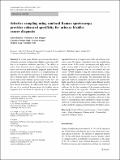| dc.contributor.author | Barman, Ishan | |
| dc.contributor.author | Dingari, Narahara Chari | |
| dc.contributor.author | Singh, Gajendra Pratap | |
| dc.contributor.author | Kumar, Rajesh | |
| dc.contributor.author | Lang, Stephen | |
| dc.contributor.author | Nabi, Ghulam | |
| dc.date.accessioned | 2016-10-24T18:00:54Z | |
| dc.date.available | 2016-10-24T18:00:54Z | |
| dc.date.issued | 2012-10 | |
| dc.date.submitted | 2012-08 | |
| dc.identifier.issn | 1618-2642 | |
| dc.identifier.issn | 1618-2650 | |
| dc.identifier.uri | http://hdl.handle.net/1721.1/104946 | |
| dc.description.abstract | In recent years, Raman spectroscopy has shown substantive promise in diagnosing bladder cancer, especially due to its exquisite molecular specificity. The ability to reduce false detection rates in comparison to existing diagnostic tools such as photodynamic diagnosis makes Raman spectroscopy particularly attractive as a complementary diagnostic tool for real-time guidance of transurethral resection of bladder tumor (TURBT). Nevertheless, the state-of-the-art high-volume Raman spectroscopic probes have not reached the expected levels of specificity thereby impeding their clinical translation. To address this issue, we propose the use of a confocal Raman probe for bladder cancer diagnosis that can boost the specificity of the diagnostic algorithm based on its suppression of the out-of-focus non-analyte-specific signals emanating from the neighboring normal tissue. In this article, we engineer and apply such a probe, having depth of field of approximately 280 μm, for Raman spectral acquisition from ex vivo normal and cancerous TURBT samples. Using this clinical dataset, a diagnostic algorithm based on principal component analysis and logistic regression is developed. We demonstrate that this approach results in comparable sensitivity but significantly higher specificity in relation to high-volume Raman spectral data. The application of only two principal components is sufficient for the discrimination of the samples underlining the robustness of the algorithm. Further, no discordance between replicate spectra is observed emphasizing the reproducible nature of the current diagnostic assessment. The high levels of sensitivity and specificity achieved in this proof-of-concept study opens substantive avenues for application of a confocal Raman probe during endoscopic procedures related to diagnosis and treatment of bladder cancer. | en_US |
| dc.description.sponsorship | National Health Service in Scotland (Tayside Endowment Funds) | en_US |
| dc.publisher | Springer-Verlag | en_US |
| dc.relation.isversionof | http://dx.doi.org/10.1007/s00216-012-6424-6 | en_US |
| dc.rights | Article is made available in accordance with the publisher's policy and may be subject to US copyright law. Please refer to the publisher's site for terms of use. | en_US |
| dc.source | Springer-Verlag | en_US |
| dc.title | Selective sampling using confocal Raman spectroscopy provides enhanced specificity for urinary bladder cancer diagnosis | en_US |
| dc.type | Article | en_US |
| dc.identifier.citation | Barman, Ishan et al. “Selective Sampling Using Confocal Raman Spectroscopy Provides Enhanced Specificity for Urinary Bladder Cancer Diagnosis.” Analytical and Bioanalytical Chemistry 404.10 (2012): 3091–3099. | en_US |
| dc.contributor.department | Massachusetts Institute of Technology. Spectroscopy Laboratory | en_US |
| dc.contributor.mitauthor | Barman, Ishan | |
| dc.contributor.mitauthor | Dingari, Narahara Chari | |
| dc.relation.journal | Analytical and Bioanalytical Chemistry | en_US |
| dc.eprint.version | Author's final manuscript | en_US |
| dc.type.uri | http://purl.org/eprint/type/JournalArticle | en_US |
| eprint.status | http://purl.org/eprint/status/PeerReviewed | en_US |
| dc.date.updated | 2016-08-18T15:23:54Z | |
| dc.language.rfc3066 | en | |
| dc.rights.holder | Springer-Verlag Berlin Heidelberg | |
| dspace.orderedauthors | Barman, Ishan; Dingari, Narahara Chari; Singh, Gajendra Pratap; Kumar, Rajesh; Lang, Stephen; Nabi, Ghulam | en_US |
| dspace.embargo.terms | N | en |
| mit.license | PUBLISHER_POLICY | en_US |
| mit.metadata.status | Complete | |
